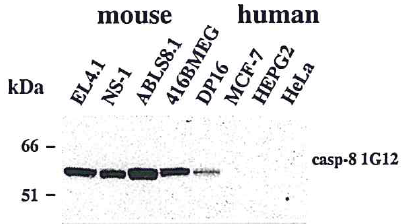anti-Caspase-8 (mouse) mAb (1G12)
| Code | Size | Price |
|---|
| AG-20T-0137-C100 | 100 ug | £250.00 |
Quantity:
Prices exclude any Taxes / VAT
Overview
Antibody Clonality: Monoclonal
Regulatory Status: RUO
Target Species: Mouse
Applications:
- Enzyme-Linked Immunosorbent Assay (ELISA)
- Flow Cytometry
- Immunohistochemistry (IHC)
- Western Blot (WB)
Shipping:
-20°C
Storage:
-20°C
Images
Documents
Further Information
Alternate Names/Synonyms:
Apoptotic Cysteine Protease; Apoptotic Protease Mch-5; CAP4; FADD-homologous ICE/ced-3-like Protease
Concentration:
1mg/ml
EClass:
32160000
Endotoxin:
<0.1EU/µg purified protein (LAL test; Lonza).
Form (Short):
liquid
Formulation:
Liquid. In PBS containing 0.02% sodium azide.
Handling Advice:
After opening, prepare aliquots and store at -20°C.Avoid freeze/thaw cycles.
Immunogen:
Recombinant mouse caspase-8 (p20 subunit).
Long Description:
Monoclonal Antibody. Recognizes the p20 subunit of mouse caspase-8. Detects bands of ~55kDa (full-length caspase-8) and ~18kDa (apoptosis-induced cleavage fragment) by Western blot. Does not cross-react with human caspase-8. Isotype: Rat IgG1kappa. Clone: 1G12. Applications: ELISA, FACS, IHC, WB. Liquid. In PBS containing 0.02% sodium azide. Procaspase-8 belongs to the family of caspases. Binding of FasL to Fas leads to formation of a receptor complex at the cellular membrane, which was named DISC. The DISC consists of oligomerized receptors, the DD-containing adaptor molecule FADD, procaspase-8, procaspase-10 and c-FLIP. The DISC structure provides a platform for the oligomerization of procaspase-8 that allows two procaspase-8 homodimers to be in the close proximity leading to the initial activation of procaspase-8. At the first cleavage step, the N-terminal p43/p41 and the C-terminal p30 cleavage products are generated. Importantly, these cleavage products already possess catalytic activity. At the second cleavage step, p43/p41 and p30 are processed to p10 and p20, respectively, which leads to the generation of the active caspase-8 heterotetramer (p20/p10)2.
NCBI, Uniprot Number:
O89110
Package Type:
Plastic Vial
Product Description:
Procaspase-8 belongs to the family of caspases. Binding of FasL to Fas leads to formation of a receptor complex at the cellular membrane, which was named DISC. The DISC consists of oligomerized receptors, the DD-containing adaptor molecule FADD, procaspase-8, procaspase-10 and c-FLIP. The DISC structure provides a platform for the oligomerization of procaspase-8 that allows two procaspase-8 homodimers to be in the close proximity leading to the initial activation of procaspase-8. At the first cleavage step, the N-terminal p43/p41 and the C-terminal p30 cleavage products are generated. Importantly, these cleavage products already possess catalytic activity. At the second cleavage step, p43/p41 and p30 are processed to p10 and p20, respectively, which leads to the generation of the active caspase-8 heterotetramer (p20/p10)2.
Purity:
>95% (SDS-PAGE)
Specificity:
Recognizes the p20 subunit of mouse caspase-8. Detects bands of ~55kDa (full-length caspase-8) and ~18kDa (apoptosis-induced cleavage fragment) by Western blot. Does not cross-react with human caspase-8.
Transportation:
Non-hazardous
UNSPSC Category:
Primary Antibodies
UNSPSC Number:
12352203
Use & Stability:
Stable for at least 1 year after receipt when stored at -20°C.
References
Apaf-1 and caspase-9 do not act as tumor suppressors in myc-induced lymphomagenesis or mouse embryo fibroblast transformation: C.L. Scott, et al.; J. Cell Biol. 164, 89 (2004) | Modifications and intracellular trafficking of FADD/MORT1 and caspase-8 after stimulation of T lymphocytes: L.A. O'Reilly, et al.; Cell Death Differ. 11, 724 (2004) | Caspase-8 serves both apoptotic and nonapoptotic roles: T.B.Kang, et al.; J. Immunol. 73, 2976 (2004) | Role of membrane sphingomyelin and ceramide in platform formation for Fas-mediated apoptosis: M. Miyaji, et al.; J. Exp. Med. 202, 249 (2005) | Fatal Hepatitis Mediated by Tumor Necrosis Factor TNFalpha Requires Caspase-8 and Involves the BH3-Only Proteins Bid and Bim: T. Kaufmann, et al.; Immunity 30, 56 (2009) | Catalytic activity of the caspase-8-FLIPL complex inhibits RIPK3-dependent necrosis: A. Oberst, et al.; Nature 471, 363 (2011) | FLIP (Flice-like inhibitory protein) suppresses cytoplasmic double-stranded-RNA-induced apoptosis and NF-B and IRF3-mediated signaling: P. Handa, et al.; Cell Commun. Signal. 9, 16 (2011) | XIAP restricts TNF- and RIP3-dependent cell death and inflammasome activation: M. Yabal, et al.; Cell Rep. 7, 1796 (2014)



